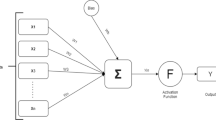Abstract
In this paper, a financial early warning information system is developed based on the multi-dimensional climate approach that is featured with a multi-dimensional index construction and the relevant multi-dimensional analysis. Requirement analysis and design issues of building an information system supporting this multi-dimensional climate approach are discussed in detail. And a case using this system to study the macro financial issues is presented to illustrate how the proposed multi-dimensional approach works in the information system we design. This research is an interdisciplinary work of economic theories, macro financial empirical studies, and software engineering. With advanced macro financial early warning theories implemented in a web application, the Macro Financial Early Warning System (FEWS) developed in this research has been proved to be effective in a trial running in the Forecasting research institute of the Chinese Academy of Sciences.
Similar content being viewed by others
References
Krugman P. A model of balance-of-payments crises. Journal of Money, Credit, and Banking, 1979, 11: 311–325
ObstfeId M. Rational and self-fulfilling balance-of-payments crises. American Economic Review,1986, 76: 72–78
Mckinnon R I, Pill H. International overborrowing: a decomposition of credit and currency risks. World Development, 1998, 26: 1267–1282
Chang R, Velasco A. A model of financial crises in emerging markets. Quarterly Journal of Economics, 2001, 116: 489–5l7
Frankel J A, Rose A K. Currency crashes in emerging markets: an empirical treatment. Journal of International Economics, 1996, 41: 35–66
Kaminsky G L, Reinhart C M. The twin crises: the causes of banking and balance-of-payments problems. American Economic Review, 1999, 89:473–500
Bussicre M, Fratzscher M. Towards a new early warning system of financial crisis. European Central Bank Working Paper,2002, 2002l45
Todd P, Benbasat I. The use of information in decision making: an experimental investigation of the impact of computer-based decision aids. MIS Quarterly, 1992, 16(3): 373–393
Bharati P, Chaudhury A. An empirical investigation of decision making satisfaction in web-based decision support systems. Decision Support Systems, 2004, 37: 187–197
Hu D P, Wang H C, Wu R M. Method for developing agent-based macro-economy decision support system. Journal of China University of Mining Technology, 2001, 30(1): 56–58
Al-Othman AN. Implementing a web-based decision support system for macro-econometric models. Kuwait Journal of Science & Engineering, 2006, 33(1): 253–265
Yang WC, Yang C. A decision engineering system over financial data warehouse. In: Proceedings of the 2005 International Conference on Neural Networks and Brain, 2005, 2: 1050–1052
Klein P A, ed. Analyzing Modern Business Cycles: Essays in Honor of Geoffrey H. Moore, Armonk, N.Y: M.E. Sharpe, Inc, 1990
Lahiri K, Moore G H. Leading Economic Indicators: New Approaches and Forecasting Records. USA: Cambridge University Press, 1991
Achuthan L, Banerji A. Beating the Business Cycle: How to Predict and Profit from Turning Points in the Economy. New York: Random House, Inc, 2004
Marcellino M. Leading indicators. In G Elliott, C W J Granger & A Timmermann (Eds.), Handbook of Economic Forecasting, 2006, 1: 879–960
Carriero A, Marcellino M. A comparison of methods for the construction of composite coincident and leading indexes for the UK. International Journal of Forecasting, 2007, 23: 219–236
Banerji A, Hiris L. A Multidimensional framework for measuring business cycles. International Journal of Forecasting, 2001(17): 333–348
Han A, Zheng G H. Wang S Y. The generalized dynamic factor model with an application to coincident index. Systems Engineering- Theory & Practice, in press, 2008
Zheng G H, Wang S Y. A study of multi-dimension prosperity and its application. Working Paper, 2008
Nilsson R. OECD leading indicators. OECD economic studies, No.9, 1987
Bry G, Boschan C. Cyclical analysis of time series: selection procedures and computer programs. National Bureau of Economic Research, N.Y, 1971
Burns A F, Mitchell WC. Measuring business cycles. National Bureau of Economic Research, N.Y, 1946
Moore G H, Shiskin J. Indicators of Business Expansions and Contractions. New York: Columbia University Press, 1967
Forni M, Hallin M, Lippi M, et al. The generalized dynamic factor model: identification and estimation. Review of Economics and Statistics, 2000, 82: 540–554
Forni M, Hallin M, Lippi M, et al. The generalized dynamic factor model: consistency and rates. Journal of Econometrics, 2004, 119: 231–255
Dong W, Gao T M, Jiang S Z, et al. Economy Periodical Fluctuation: Analysis and Warning. China: Jilin University Press, 1998
Zhang X, Zheng G H, Lai K K, et al. Forecasting macroeconomic using integrated early warning system. Advances in Forecasting Science and Risk Management I, Lecture Notes in Decision Sciences, 2007, 10: 256–278
Banque De France. The financial cycle: factors of amplification and possible policy implications for financial and monetary authorities. Banque de France Bulletin, 2001, 95
Zhang X, Zheng G H, Shang W, et al. An integrated decision support framework for macroeconomic policy making based on early warning theories. International Journal of Information Technology & Decision Making, in press, 2008
Author information
Authors and Affiliations
Corresponding author
Rights and permissions
About this article
Cite this article
Zheng, G., Zhang, X., Shang, W. et al. Macro finance early warning system. Front. Comput. Sci. China 3, 226–234 (2009). https://doi.org/10.1007/s11704-009-0024-4
Received:
Accepted:
Published:
Issue Date:
DOI: https://doi.org/10.1007/s11704-009-0024-4




